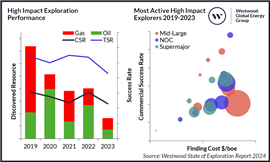Westwood: Energy transition strategies affecting drilling
June 07, 2024
High Impact exploration average discovery size declines, finding costs increase
Energy market research and consultancy firm Westwood Global Energy Group reports that, despite favorable oil prices in 2022, high impact exploration drilling in 2023 declined by 21%.
The decline was due in large part to energy transition strategies, industry consolidation, rising well costs and reduced activity in former hotspots, the company said.

Further 2023 analysis found that the commercial success rate is down seven percentage points on the previous year – the lowest since 2018. Fewer giant discoveries (>500mmboe) have resulted in a year-on-year decline in the average discovery size, down from nearly 500mmboe in 2019 to ~220mmboe in 2023, the smallest since 2014. At the same time, overall drilling finding costs have increased by a factor of six since 2019 to $1.2/boe. The commercial success rate in frontier plays returned to the long-term average at less than 10%, the company reported.
The findings also highlighted a decrease in the number of companies participating in high impact drilling (down from 99 in 2019 to 68 in 2023), with supermajors and NOCs continuing to account for the majority of high impact well equity, at ~60% between 2019-2023, and leading the way in terms of both discovered resource and commercial success rate.
“There is still cause for optimism, however,” the report stated. “Recent discoveries in Namibia’s Orange basin demonstrate that there are still significant volumes of hydrocarbons to be found and cycle times are reducing, with oil discoveries achieving first production, on average, a year faster than gas discoveries.”
“The relationship between exploration drilling and the previous year’s oil price has broken. High oil prices previously led to high levels of exploration drilling,” said Graeme Bagley, Head of Global Exploration and Appraisal at Westwood. “The appetite for exploration is still there but energy transition strategies are having a significant impact on the way the companies choose to replenish their reserves base, with industry consolidation and new technologies also having a part to play.”
MAGAZINE
NEWSLETTER

CONNECT WITH THE TEAM







